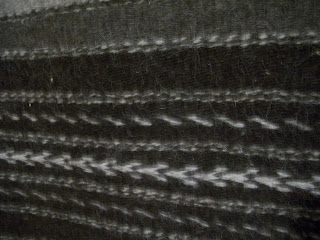 |
| Almost every decoration in Susan's home speaks "Bunny!" |
 |
| Today we focused on Navajo plying and wool combing. Connie had this lovely bag of Polwarth that she had purchased from Skyloom Weavers |
 |
| Nice soft fibers and lovely color combinations. Connie wanted to keep the colors pure so was pulling out each lock to separate the colors. And she was wool combing these locks. |
 |
| She needed a stationary stand to hold her combs and lo and behold, her hubby stepped with this great technique, grooved into the wood block and held tight with a large C clamp and away she goes. |
 |
| The comb is loaded up with each lock |
 |
| And then she is ready to comb, starting with the wool tips |
 |
| This combing action loads the straighten wool locks onto the other comb |
 |
| Just keep on combing until most of the fiber is transferred to the second comb. |
 |
| The waste fiber in her left hand is discarded or use it as a novelty element into a spun yarn. |
 |
| Task completed! Or you can do this process once again |
 |
| Now, how do you take off the fiber that has been combed? |
 |
| You pull out a small section (in other words, you spin out a tail and ply on itself) |
 |
| Now, find your Diz or in case you don't have one handy, use a bead. Pull your spun portion through the bead and go from there |
 |
| You are pulling the combed fibers through the diz which creates a roving |
 |
| Keep pulling through the diz until you come to the end |
 |
| you have a nice roving of combed fiber--proceed to your spinning wheel! |
 |
| Connie has a nice collection of combed wool batts ready for her spinning wheel! Thanks Connie for this demo and refresher! Video on how to wool comb |


















































